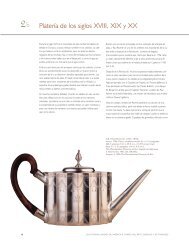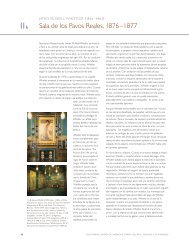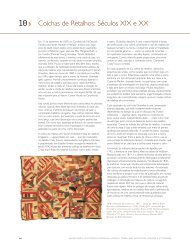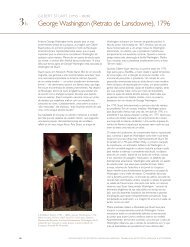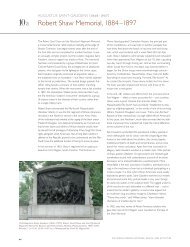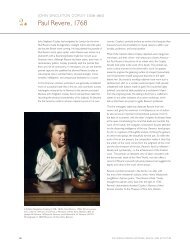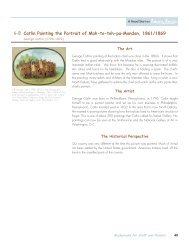4-B Hiram Powers (1805–1873) - Picturing America
4-B Hiram Powers (1805–1873) - Picturing America
4-B Hiram Powers (1805–1873) - Picturing America
Create successful ePaper yourself
Turn your PDF publications into a flip-book with our unique Google optimized e-Paper software.
4-B <strong>Hiram</strong> <strong>Powers</strong> (<strong>1805–1873</strong>)<br />
Benjamin Franklin, 1862<br />
4-B <strong>Hiram</strong> <strong>Powers</strong> (<strong>1805–1873</strong>), Benjamin Franklin,<br />
1862. Marble, height 97 ½ in., width 34 7/8 in., depth<br />
21 5/8 in. (247.7 x 88.6 x 54.9 cm.). U.S. Senate<br />
Collection.<br />
The Art<br />
A Head Start on<br />
This larger-than-life sized sculpture of Benjamin Franklin was made in 1862 by<br />
<strong>Hiram</strong> <strong>Powers</strong>, a famous <strong>America</strong>n sculptor of that time. <strong>Powers</strong> was very familiar<br />
with a carved bust of Franklin by a French sculptor named Jean-Antoine Houdon,<br />
as well as a painting of Franklin by Scottish artist David Martin, both done during<br />
Franklin’s lifetime. <strong>Powers</strong> drew inspiration from these works of art to create the<br />
details he needed to sculpt the head, the most important part of the statue. <strong>Powers</strong><br />
sent for actual clothing worn by Franklin, which he copied in his sculpture. The<br />
clothing gave him clear ideas of how thick to make the outer coat and the thin cotton<br />
stockings that wrinkle at the ankles. Franklin is standing in a relaxed and thoughtful<br />
position with one leg slightly bent, an elbow resting on a tree stump, and his hand<br />
on his chin.<br />
The Artist<br />
At the age of 30, <strong>Powers</strong> had gained popularity as a sculptor by creating a lifelike<br />
bust of President Andrew Jackson. He was especially famous for being able to make<br />
marble look like skin. His sculpture of 1843 called The Greek Slave made him<br />
famous all over the world. <strong>Powers</strong> moved to Italy where he set up his own studio.<br />
In Italy, there were plenty of good helpers and the models he needed for sculpting.<br />
He used the same type of Italian marble to sculpt the Franklin statue that he used for<br />
the full-length sculpture of Thomas Jefferson, which he made about the same time.<br />
The Franklin statue stands in the Senate of the United States Capitol Building in<br />
Washington, D.C., in the same spot where it was placed after it was delivered to<br />
the building in 1862.<br />
The Historical Perspective<br />
When the United States of <strong>America</strong> was created, Franklin was one of the most<br />
important people of his day. In 1858, U.S. government officials felt such an important<br />
person in <strong>America</strong>n history should be honored by one of the most talented sculptors<br />
of their day. Some thought <strong>Powers</strong> should have sculpted Franklin in robes worn<br />
by the ancient Greeks or Romans rather than in 18th-century garments, but <strong>Powers</strong><br />
disagreed. By having Franklin rest an elbow on a tree trunk struck by lightning,<br />
<strong>Powers</strong> also was able to show Franklin’s contribution to science, expressed in his<br />
famous book Experiments and Observations on Electricity of 1751.<br />
Background for Staff and Parents 27
?<br />
Describing<br />
✔ Look at this statue. What do you see?<br />
✔ How do you think the statue feels to<br />
touch? Children might say smooth, hard,<br />
cold, etc.<br />
✔ Why would a sculptor want to make a<br />
statue of someone? Children might say the<br />
person is famous, loved, or helps us have<br />
kind thoughts when we see him or her.<br />
✔ What would be the hardest thing about<br />
making a statue like this one? Children<br />
might say making it out of a block of stone,<br />
making it smooth to touch, creating an<br />
accurate face of someone people know,<br />
having it show feelings or thoughts, making<br />
the hair and eyes look real, etc.<br />
angle<br />
chisel<br />
display<br />
leader<br />
mallet<br />
marble<br />
Connecting and<br />
Extending<br />
Introducing Vocabulary<br />
pensive<br />
ponder<br />
pose<br />
sculpt<br />
sculptor<br />
sculpture<br />
A Head Start on<br />
Conversations and Teaching Activities<br />
Head Start Children ages 3 to 5<br />
Encourage children to look closely at this sculpture––see the accuracy of the sculpted objects, the<br />
textures, the size of the face, hands, feet, and other features. Introduce new vocabulary and find books<br />
that relate to the artwork.<br />
Analyzing and Interpreting<br />
Ask the following questions to stimulate thinking and discussion:<br />
• The name of this artwork is Benjamin Franklin. Do you know why it is named<br />
that?<br />
• Do you think it would it be easier to make a statue of stone, wood, or clay?<br />
Why would one material be easier to use than either of the others? Which<br />
would last longer?<br />
• How would you make a sculpture of stone?<br />
• Since this lesson covers a stone sculpture, it’s probably not necessary to<br />
discuss how many metal statues are formed, but it might come up. It is important<br />
that the children understand they are not chiseled from a piece of metal but are<br />
first made of clay that hardens. A form or mold is made and metal is poured<br />
into the form and later polished.<br />
• How long do you think you could stay in the same position to pose for<br />
someone to make a statue of you? Let’s try it.<br />
• Are there other things you would like to tell me about this sculpture?<br />
Books<br />
A Picture Book of Benjamin Franklin by David Adler (Holiday House, 1991)<br />
Benjamin Franklin’s work as an inventor and statesman are highlighted.<br />
Benjamin Franklin by Ingri D’Aulaire (Tandem Library Books, 1950)<br />
First-time readers meet one of <strong>America</strong>’s most extraordinary historical figures.<br />
Books continued on page 29<br />
28
Connecting and Extending<br />
continued...<br />
Related Family Literacy<br />
Experiences<br />
Parents and children can:<br />
✔ play freeze dance to different types of<br />
music.<br />
✔ visit a museum and look for different<br />
types of sculptures.<br />
✔ create a book about what the world<br />
would be like if there wasn’t electricity.<br />
A Head Start on<br />
Books continued...<br />
Benjamin Franklin (Rookie Biographies) by Wil Mara (Scholastic Library<br />
Publishing, 2006)<br />
This biography of Benjamin Franklin notes his work as an inventor, printer, scientist,<br />
and statesman.<br />
How Ben Franklin Stole the Lightning by Rosalyn Schanzer (HarperCollins<br />
Publishers, 2002)<br />
This book focuses on Benjamin Franklin’s role as an inventor of whimsical gadgets<br />
and practical contraptions, with an emphasis on his experiment of flying a kite<br />
during a rainstorm.<br />
Now & Ben: The Modern Inventions of Benjamin Franklin by Gene Barretta<br />
(Henry Holt and Company, 2006)<br />
Readers will learn about the inventions and inspiration of Benjamin Franklin and<br />
how they’ve stood the test of time.<br />
The Story of Benjamin Franklin by Patricia Pingry (Ideals Publications, 2002)<br />
This book provides a simple introduction to the multifaceted life of<br />
Benjamin Franklin.<br />
Related Educational<br />
Experiences<br />
✔ Ask how a sculpture is different from<br />
a painting. (You can see every side of<br />
a sculpture––the front, back, side, top,<br />
bottom; in a painting, you see only<br />
one side.) A sculpture is much more<br />
real because you can feel it and see it<br />
in so many ways. Demonstrate this by<br />
having three children stand on different<br />
sides of a sculpture and tell what<br />
they see––how many eyes, ears, and<br />
other features each of them can see to<br />
illustrate that even though they are all<br />
looking at the same object, none of<br />
them are seeing the same thing.<br />
✔ Make a newspaper hat by unfolding<br />
three or four pages of a newspaper,<br />
shaping it to a child’s head, and<br />
wrapping the band with masking tape<br />
to make a hat band. Carefully roll the<br />
paper from the ends, crinkling the rim<br />
so it holds its shape. Bring the rim up<br />
to the cap on three sides and staple or<br />
tape it to make a three-cornered hat. As<br />
the sculpture is being discussed, bring<br />
a volunteer to the front of the room and<br />
place the hat on his or her head. Ask<br />
the child to pose like Franklin. Have<br />
all the children stand that way. Explain<br />
that this is how artists have made<br />
statues for thousands of years––with<br />
one leg slightly bent forward and the<br />
other straight. It is called contrapposto,<br />
a popular Roman and Greek stance.<br />
continues on next page...<br />
29
Connecting and Extending continued...<br />
Related Educational<br />
Experiences continued…<br />
✔ Have the children imitate Franklin’s<br />
pose. Ask the children what they think<br />
of when someone is looking away,<br />
with hand resting on the chin. You can<br />
take pictures to compare the children’s<br />
poses to the sculpture.<br />
✔ Discuss the post Franklin is leaning<br />
on. What is it supposed to be made<br />
of? Explain that Franklin was famous<br />
for his scientific studies of lightning and<br />
electricity. Point out the long line that<br />
goes from the top of the tree post to<br />
the bottom. It is a sign that the tree was<br />
hit by lightning. The sculptor wanted<br />
to honor Franklin for his discovery of<br />
electricity as much as for his work in<br />
creating our government.<br />
✔ Discuss electricity and how it is<br />
used: for lighting, to cook, to wash<br />
and sometimes dry clothes, to power<br />
radios and TVs, etc.<br />
✔ If possible, take the children to see<br />
a full-size statue of a man or woman,<br />
or bring in a bust or statue for them<br />
to see. Stone statues would be ideal<br />
because the children can feel them<br />
and see how hard the material is.<br />
Talk about how big statues are that we<br />
see in a park–– they usually are larger<br />
than real life. The statue of Franklin is<br />
97 inches tall. An average man is 70<br />
inches tall. Show them on a wall how<br />
tall 97 inches is and hold the picture<br />
A Head Start on<br />
up so they can imagine the sculpture<br />
being that tall.<br />
✔ Show children pictures of statues<br />
being made and demonstrate how a<br />
chisel and mallet are used to make<br />
them. Show a 25-pound cube of dried<br />
clay being shaped with a real mallet<br />
and chisel––without the sharp debris<br />
thrown off by stone. A mallet and<br />
sculpting chisel often can be borrowed<br />
from a university art department or<br />
local art supply store.<br />
✔ Give each child a large piece of<br />
salt clay. Ask the children to sculpt<br />
something from the clay. Because<br />
the act of creating something in three<br />
dimensions is very different from<br />
painting, the children can appreciate<br />
that their “art” will look different from<br />
any angle from which it is viewed.<br />
The ideas listed are just a few of the<br />
many activities that could be used to<br />
introduce or extend children’s learning.<br />
Your knowledge of your children and<br />
families supports your ability to ensure<br />
positive learning experiences and<br />
outcomes for students. As an educator,<br />
you probably have ideas for books,<br />
songs, finger plays, and activities that<br />
you have thought of when introducing<br />
or extending children’s learning related<br />
to the “A Head Start on <strong>Picturing</strong><br />
<strong>America</strong>” artworks. We encourage<br />
you to confer with your colleagues,<br />
visit the local library or bookstore, and<br />
share your ideas with others.<br />
30



